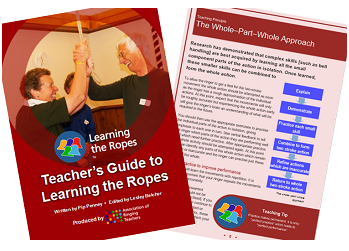Feedback - mind your language
Feedback is an important teaching tool when progressing a learner with their ringing. Without feedback it is difficult for a ringer to understand and modify their ringing. Learners who obtain feedback tend to perform more consistently over the long term.
Verbal feedback
One type of feedback which a ringer will receive is verbal feedback from the teacher. This verbal feedback can be positive, negative or neutral (informational with no positive or negative connotations, such as: "remember to keep your handstroke lead open.") Both positive and negative feedback have their role in teaching but care must be taken as to the result the feedback has on the ringer’s attitude to further learning. Feedback is a powerful tool and should be used carefully and thoughtfully.
Positive feedback can:
- Motivate ringers
- Reinforce the desired technique – e.g. good leading or striking
- Correct technique
Positive feedback provides encouragement; ringers like to receive praise especially when it is sincere and honest.
Negative feedback can:
- Demotivate ringers
- Change attitudes for the worse
- Undermine a ringer’s confidence
Negative feedback does not encourage ringers, may be counterproductive to their motivation and contribute to them giving up easily.
Self-confidence
Teachers want their ringers to:
- Be enthusiastic and take a positive attitude
- Show perseverance even when things are hard to learn
- Attempt challenging tasks such as moving on to a larger number of bells, learn new and more complex methods or learn the Standard 8.
To be able to act in this way the ringer must feel confident in their own ability to succeed. Self-confidence is an indicator of the fact that the ringer believes in their own ability. There is a clear relationship between self-confidence and success. This means that teachers need to concern themselves with building self-confidence in their ringers. The behaviour of the teacher will have a strong effect on the self-confidence of a ringer.
Teachers should give out the message that all ringers can improve and succeed with practice and application. To help maintain self-confidence the teacher needs to ensure that the ringer feels they are of value to the teacher no matter where the ringer is in terms of skill development and how advanced their ringing might be.
The way in which the teacher uses feedback will affect the way the learner feels. It should be the aim of a teacher to use feedback in a manner which leaves the ringer feeling positive.
Don't say don't
“DON’T” is one of the most negative words a teacher can use! Used frequently it will demotivate, especially during the early stages of learning to ring and when learning to handle a bell. Unfortunately, it is commonly used! Teachers are notorious for recognising and correcting errors more often than noticing correct aspects of movements. The positive aspects of performance should be recognised and used in the feedback to the ringer.
Teachers should avoid the use of the word “Don’t” where ever possible.
Teachers should not use sarcasm and should never, never shout at a ringer unless there is an unsafe situation that requires immediate action.
The next time you are teaching, see if you can count how many times you use the word “Don’t”.
The use of ‘Good – Better – How’ provides the teacher with a suitable technique
How could you phrase your feedback to avoid using the word, "don't?" A teacher should start with what was good about the ringer’s performance or attitude, next should come better - what needs to be improved - and following that how - guidance on what the ringer should do to improve performance. This feedback should be followed up with the opportunity to practise what needs to be improved.
Immediate feedback is more useful for improving performance than delayed feedback; if the feedback is delayed it is more likely that the ringer will have forgotten exactly how they performed.
And remember that feedback must be accurate but to be effective the ringer must be in the right frame of mind to accept the feedback being given.
To make the feedback more acceptable to the ringer, verbal feedback can be thought of in terms of a sandwich:
- Good - first the teacher makes a positive comment to attune the ringer to forthcoming comments (feedback). This is represented by the top piece of bread.
- Better – the teacher gives the feedback about what needs to be worked on. This is represented the sandwich filling.
- How – the teacher provides the advice and the opportunity for the ringer to improve their performance. This is represented by the underneath piece of bread.

Teacher's Guide to Learning the Ropes
A book for any ringing teacher, covering the “how to” from the first bell handling lesson to teaching someone how to ring their first method.
The Teacher's Guide and its companion publication The Ringer's Guide to Learning the Ropes are both available from the ART shop.
Pip Penney